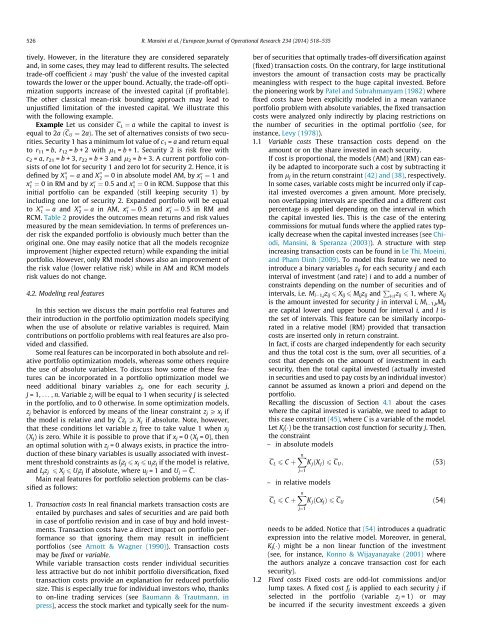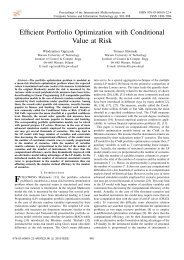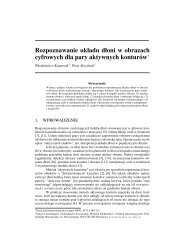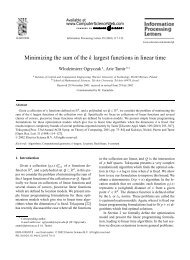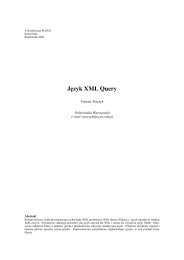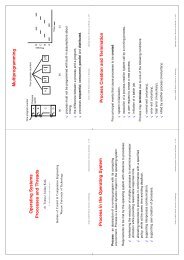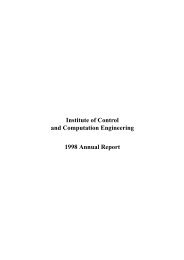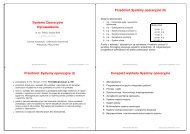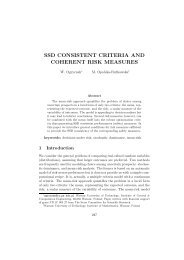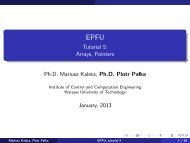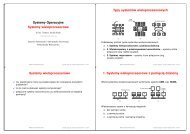Twenty Years of Linear Programming Based Portfolio Optimization
Twenty Years of Linear Programming Based Portfolio Optimization
Twenty Years of Linear Programming Based Portfolio Optimization
Create successful ePaper yourself
Turn your PDF publications into a flip-book with our unique Google optimized e-Paper software.
526 R. Mansini et al. / European Journal <strong>of</strong> Operational Research 234 (2014) 518–535<br />
tively. However, in the literature they are considered separately<br />
and, in some cases, they may lead to different results. The selected<br />
trade-<strong>of</strong>f coefficient k may ’push’ the value <strong>of</strong> the invested capital<br />
towards the lower or the upper bound. Actually, the trade-<strong>of</strong>f optimization<br />
supports increase <strong>of</strong> the invested capital (if pr<strong>of</strong>itable).<br />
The other classical mean-risk bounding approach may lead to<br />
unjustified limitation <strong>of</strong> the invested capital. We illustrate this<br />
with the following example.<br />
Example Let us consider C L ¼ a while the capital to invest is<br />
equal to 2a ðC U ¼ 2aÞ. The set <strong>of</strong> alternatives consists <strong>of</strong> two securities.<br />
Security 1 has a minimum lot value <strong>of</strong> c 1 = a and return equal<br />
to r 11 = b, r 12 = b + 2 with l 1 = b + 1. Security 2 is risk free with<br />
c 2 = a, r 21 = b +3,r 22 = b + 3 and l 2 = b + 3. A current portfolio consists<br />
<strong>of</strong> one lot for security 1 and zero lot for security 2. Hence, it is<br />
defined by X 00 1 ¼ a and X00 2 ¼ 0 in absolute model AM, by x00 1 ¼ 1 and<br />
x 00 1 ¼ 0 in RM and by x00 1 ¼ 0:5 and x00 1<br />
¼ 0 in RCM. Suppose that this<br />
initial portfolio can be expanded (still keeping security 1) by<br />
including one lot <strong>of</strong> security 2. Expanded portfolio will be equal<br />
to X 00 1 ¼ a and X00 2 ¼ a in AM, x00 1 ¼ 0:5 and x00 1<br />
¼ 0:5 in RM and<br />
RCM. Table 2 provides the outcomes mean returns and risk values<br />
measured by the mean semideviation. In terms <strong>of</strong> preferences under<br />
risk the expanded portfolio is obviously much better than the<br />
original one. One may easily notice that all the models recognize<br />
improvement (higher expected return) while expanding the initial<br />
portfolio. However, only RM model shows also an improvement <strong>of</strong><br />
the risk value (lower relative risk) while in AM and RCM models<br />
risk values do not change.<br />
4.2. Modeling real features<br />
In this section we discuss the main portfolio real features and<br />
their introduction in the portfolio optimization models specifying<br />
when the use <strong>of</strong> absolute or relative variables is required. Main<br />
contributions on portfolio problems with real features are also provided<br />
and classified.<br />
Some real features can be incorporated in both absolute and relative<br />
portfolio optimization models, whereas some others require<br />
the use <strong>of</strong> absolute variables. To discuss how some <strong>of</strong> these features<br />
can be incorporated in a portfolio optimization model we<br />
need additional binary variables z j , one for each security j,<br />
j =1,..., n. Variable z j will be equal to 1 when security j is selected<br />
in the portfolio, and to 0 otherwise. In some optimization models,<br />
z j behavior is enforced by means <strong>of</strong> the linear constraint z j P x j if<br />
the model is relative and by Cz j P X j if absolute. Note, however,<br />
that these conditions let variable z j free to take value 1 when x j<br />
(X j ) is zero. While it is possible to prove that if x j =0(X j = 0), then<br />
an optimal solution with z j = 0 always exists, in practice the introduction<br />
<strong>of</strong> these binary variables is usually associated with investment<br />
threshold constraints as l j z j 6 x j 6 u j z j if the model is relative,<br />
and L j z j 6 X j 6 U j z j if absolute, where u j = 1 and U j ¼ C.<br />
Main real features for portfolio selection problems can be classified<br />
as follows:<br />
1. Transaction costs In real financial markets transaction costs are<br />
entailed by purchases and sales <strong>of</strong> securities and are paid both<br />
in case <strong>of</strong> portfolio revision and in case <strong>of</strong> buy and hold investments.<br />
Transaction costs have a direct impact on portfolio performance<br />
so that ignoring them may result in inefficient<br />
portfolios (see Arnott & Wagner (1990)). Transaction costs<br />
may be fixed or variable.<br />
While variable transaction costs render individual securities<br />
less attractive but do not inhibit portfolio diversification, fixed<br />
transaction costs provide an explanation for reduced portfolio<br />
size. This is especially true for individual investors who, thanks<br />
to on-line trading services (see Baumann & Trautmann, in<br />
press), access the stock market and typically seek for the number<br />
<strong>of</strong> securities that optimally trades-<strong>of</strong>f diversification against<br />
(fixed) transaction costs. On the contrary, for large institutional<br />
investors the amount <strong>of</strong> transaction costs may be practically<br />
meaningless with respect to the huge capital invested. Before<br />
the pioneering work by Patel and Subrahmanyam (1982) where<br />
fixed costs have been explicitly modeled in a mean variance<br />
portfolio problem with absolute variables, the fixed transaction<br />
costs were analyzed only indirectly by placing restrictions on<br />
the number <strong>of</strong> securities in the optimal portfolio (see, for<br />
instance, Levy (1978)).<br />
1.1 Variable costs These transaction costs depend on the<br />
amount or on the share invested in each security.<br />
If cost is proportional, the models (AM) and (RM) can easily<br />
be adapted to incorporate such a cost by subtracting it<br />
from l j in the return constraint (42) and (38), respectively.<br />
In some cases, variable costs might be incurred only if capital<br />
invested overcomes a given amount. More precisely,<br />
non overlapping intervals are specified and a different cost<br />
percentage is applied depending on the interval in which<br />
the capital invested lies. This is the case <strong>of</strong> the entering<br />
commissions for mutual funds where the applied rates typically<br />
decrease when the capital invested increases (see Chiodi,<br />
Mansini, & Speranza (2003)). A structure with step<br />
increasing transaction costs can be found in Le Thi, Moeini,<br />
and Pham Dinh (2009). To model this feature we need to<br />
introduce a binary variables z ij for each security j and each<br />
interval <strong>of</strong> investment (and rate) i and to add a number <strong>of</strong><br />
constraints depending on the number <strong>of</strong> securities and <strong>of</strong><br />
intervals, i.e. M i 1,j z ij 6 X ij 6 M ij z ij and P i2I z ij 6 1, where X ij<br />
is the amount invested for security j in interval i, M i 1,j ,M ij<br />
are capital lower and upper bound for interval i, andI is<br />
the set <strong>of</strong> intervals. This feature can be similarly incorporated<br />
in a relative model (RM) provided that transaction<br />
costs are inserted only in return constraint.<br />
In fact, if costs are charged independently for each security<br />
and thus the total cost is the sum, over all securities, <strong>of</strong> a<br />
cost that depends on the amount <strong>of</strong> investment in each<br />
security, then the total capital invested (actually invested<br />
in securities and used to pay costs by an individual investor)<br />
cannot be assumed as known a priori and depend on the<br />
portfolio.<br />
Recalling the discussion <strong>of</strong> Section 4.1 about the cases<br />
where the capital invested is variable, we need to adapt to<br />
this case constraint (45), whereC is a variable <strong>of</strong> the model.<br />
Let K j () be the transaction cost function for security j. Then,<br />
the constraint<br />
– in absolute models<br />
C L 6 C þ Xn<br />
K j ðX j Þ 6 C U ;<br />
j¼1<br />
– in relative models<br />
C L 6 C þ Xn<br />
K j ðCx j Þ 6 C U<br />
j¼1<br />
ð53Þ<br />
ð54Þ<br />
needs to be added. Notice that (54) introduces a quadratic<br />
expression into the relative model. Moreover, in general,<br />
K j () might be a non linear function <strong>of</strong> the investment<br />
(see, for instance, Konno & Wijayanayake (2001) where<br />
the authors analyze a concave transaction cost for each<br />
security).<br />
1.2 Fixed costs Fixed costs are odd-lot commissions and/or<br />
lump taxes. A fixed cost f j is applied to each security j if<br />
selected in the portfolio (variable z j = 1) or may<br />
be incurred if the security investment exceeds a given


